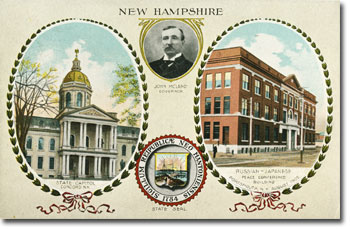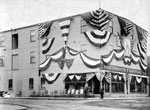 LEGACY
LEGACY

Legacy, Part Two: Aftermath of the Treaty
Balance of Power in Pacific
Certainly Roosevelt’s goal for a balance of power in the Far East was established, at least for a time. For Japan, its military victories and rapid industrial growth cemented its position as a powerful nation. Japan’s military victories over Russia destroyed the myth of European invincibility over colonial peoples. Local independence movements through Asia were strengthened because of an Asian nation’s military success against a European nation. The weakness of Russia’s army and navy upset the balance of power in Europe and helped set the stage for World War I. Meanwhile, Japan proceeded on an imperialistic course on the Asian mainland that led to a war with China in 1937, an event many historians call the beginning of World War II.
Russia and Japan
Ironically, Japan and Russia drew closer diplomatically in the years after 1905 and, despite skirmishes in 1939, after Japan invaded China, Russia and Japan signed a peace treaty in September of that year. In April 1941, after Germany had begun the war in Europe, Russia and Japan signed a neutrality agreement that lasted until August 1945 when Japan's surrender was imminent following the atomic bombing of Hiroshima. The Soviet Union declared war on Japan despite the existing Japan-Soviet neutrality agreement. Three days after the war ended, Soviet troops took back southern Sakhalin and occupied the Kuril Islands, which then belonged to Japan, and in early September completed the occupation of the four northern islands (Etorofu, Kunashiri, Shikotan, and Habomai) that are now in dispute.
Although World War II hostilities ended in 1945, Japan and Russia have yet to sign a final peace treaty primarily over the territorial issue of these four islands Japan calls the Northern Territories. Discussions between Russia and Japan have continued intermittently for over sixty years and many economic and cultural agreements have been signed, but no permanent agreement has occurred.
New Hampshire and Portsmouth
Before leaving New Hampshire on September 5, Komura paid a courtesy call on Governor McLane, surprising the state’s chief executive with a donation of $10,000 as a token of appreciation for the hospitality received during the conference.
In a note sent to the governor, the Japanese requested that “you will be good enough to utilize (the donation) for such charitable purposes in the State of New Hampshire as your Excellency may deem fit.” Three days later, the Russians made a similar donation.
The Russians and the Japanese in gratitude for the hospitality they received apparently made these donations. Calvin Page, trustee for the estate of Frank Jones that owned the hotel, picked up the bill for housing both delegations, a cost charged to the estate since the Wentworth was under the control of the Harvey and Wood management company. Charles A. Hazlett recounted this story in his History of Rockingham County: “Judge Page, through the president and Governor McLane, invited the peace delegates to the number of nearly one hundred, including all their attaches, to live at the big hotel free of charge so long as the conference should last; and the delegates and all of their attendants from both nations lived there for more than thirty days at a cost to the Jones estate of over twenty-five thousand dollars.”
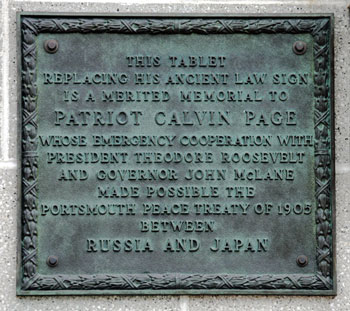
Portsmouth plaque honors Calvin Page for his role in providing accommodations for the two delegations.
Portsmouth's Page Memorial
In 1951, a bronze plaque in memory of Judge Page was placed on the side of 33 Pleasant Street, Page’s old law office. Former New Hampshire governor John H. Bartlett, who was Page’s son-in-law, erected the plaque. The inscription reads: “This tablet, replacing his ancient law sign, is a merited memorial to Patriot Calvin Page whose emergency cooperation with President Theodore Roosevelt and Gov. John McLane made possible the Portsmouth Peace Treaty of 1905 between Russia and Japan.”
The Japanese Fund
To reciprocate his gratitude to the Russians and the Japanese for their $10,000 gifts, McLane used the money to set up the Russian-Japanese Fund and purchased bonds from each country. Revenue from the Russian bonds ceased in 1917 after the revolution when the bonds became worthless. The Russians have refused to honor any requests to reinstate the money and in 1963, an act of the New Hampshire legislature dropped the Russian name from the fund title. Japan, meanwhile, continued to honor its commitment until World War II when interest payments ceased. The funds were restored by Japan in 1951, including payment of the nine years’ lost interest and, in 1965 the fund’s trustees reinvested the money in American bonds. When the seventy-fifth anniversary of the conference was celebrated in 1980, the fund had accrued to almost $40,000. The principal doesn’t increase since all of the interest must be expended annually. Currently, the proceeds are distributed to a variety of causes ranging from organ transplants to drug rehabilitation programs.
Treaty Furniture
Immediately after treaty was signed, the furniture used by both delegations in the General Stores Building was sold by the Portsmouth Furniture Company, although when Admiral Mead allowed large numbers of people to visit the conference building on Thursday, September 7, the furniture was still in place. The furniture was supposed to have been sold at regular prices, not inflated because of historical value.
The Herald reported on September 14, that the chairs used by Witte and Komura and the actual table used for the signing were purchased by “Mrs. Parks, the wife of the civil engineer (Rear Admiral Charles W. Parks) at the navy yard.” Rear Admiral Parks was a graduate of Rensselaer Polytechnic Institute, Troy, New York and his family gave the table to the college in 1930. Historian Thomas C. Wilson borrowed the table for display in Portsmouth during the city’s 350th anniversary celebration.
As an expert on the Treaty of Portsmouth, Wilson sought to collect information and memorabilia associated with the event. In 1957, with the assistance of then Portsmouth librarian Dorothy M. Vaughan, Wilson published The Peace of Portsmouth, a booklet with a brief text and many photographs relating to the conference.
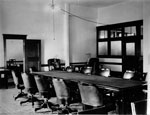
The main conference room with its furniture in place. View larger image.
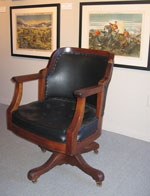
Baron Komura's chair at the treaty table. Portsmouth Athenaeum collection. View larger image.

The conference table is in the Museum Meiji-Mura in Inuyama City, Aich Prefecture, Japan. View larger image.
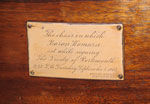
Plaque on Komura's chair (pictured left). Portsmouth Athenaeum collection. View larger image.
Eventually Masayoshi Matsumura, Consul, Japanese Information Service at the Japanese Consulate in New York City, acquired the table and it is now in the Museum Meiji-Mura in Inuyama City, Aich Prefecture, Japan. There is a replica table in the Komura Memorial Museum in Nichinan.
Although Wilson had opposed the acquisition of the table by the Japanese, he was able to purchase two conference chairs including one used by Komura. The chairs are now in the collection of the Portsmouth Athenaeum.

